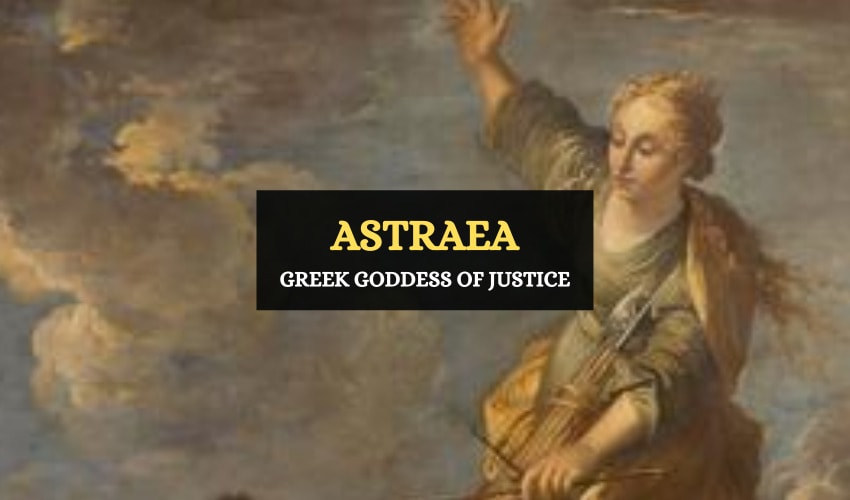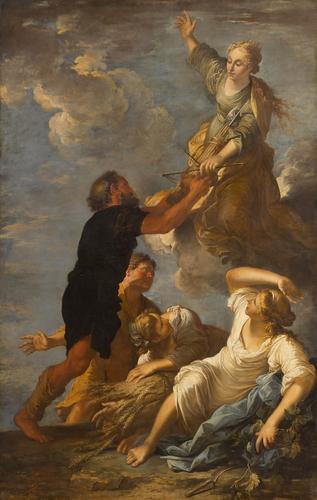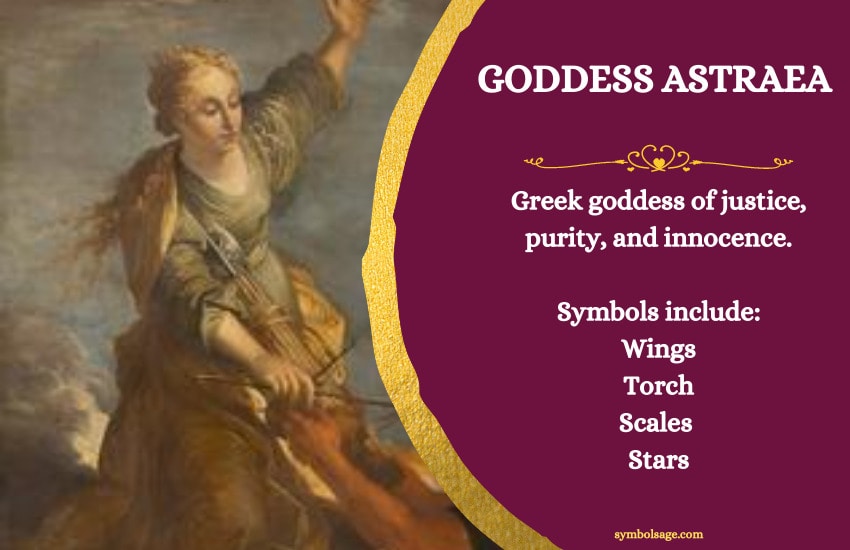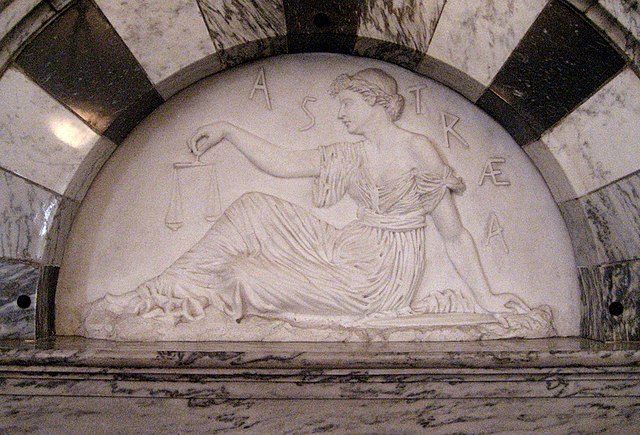
Table of Contents
In ancient Greek mythology, there were several deities related to the notion of moral balance (or ‘sophrosyne’). Among these, Astraea, the virgin goddess of justice, stands out for being the last deity who fled away from the world of mortals, when the Golden Age of humanity came to its end.
Despite being a lesser deity, Astraea held a special place, as one of Zeus’ aides. In this article, you will find more about the attributes and symbols that are associated with the figure of Astraea.
Who Was Astraea?

Astraea’s name means ‘star-maiden’, and, as such, she can be counted among the celestial deities. Astraea was one of the personifications of justice in the Greek pantheon, but as a virgin goddess, she was also related to purity and innocence. She is commonly associated with Dike and Nemesis, the goddesses of moral justice and rightful indignation. The goddess Justitia was the Roman equivalent of Astraea. Astraea shouldn’t be confused with Asteria, who was the goddess of the stars.
In Greek myths, the couple most frequently mentioned as Astraea’s parents are Astraeus, god of dusk, and Eos, goddess of the Dawn. According to this version of the myth, Astraea would be sister to the Anemoi, the four divine winds, Boreas (wind of the north), Zephyrus (wind of the west), Notus (wind of the south), and Eurus (wind of the east).
However, according to Hesiod in his didactic poem Works and Days, Astraea is the daughter of Zeus and the Titaness Themis. Hesiod also explains that Astraea can be usually found sitting next to Zeus, which is probably why in some artistic representations the goddess is portrayed as one of the keepers of Zeus’ rays.
When Astraea left the world of the mortals out of disgust, for the corruption and wickedness that had spread among humanity, Zeus transformed the goddess into the Virgo constellation.
The ancient Greeks believed that one day Astraea would come back to the Earth, and that her return would mark the beginning of a new Golden Age.
Symbols of Astraea

Astraea’s representations frequently depict her with the traditional attire of a star-deity:
- A set of feathered wings.
- A golden aureole above her head.
- A torch in one hand.
- A starry hairband on her head.
Most of the elements of this list (the golden aureole, the torch, and the starry hairband) symbolize the brightness that ancient Greeks associated with celestial bodies.
It’s worth noting that, in Greek mythology, even when a heavenly god or goddess was represented with a crown, this was still just a metaphor for the rays of light that were irradiated by the deity’s head, and not a sign of preeminence. In fact, the Greeks considered most of the gods that populated the sky as second rank divinities, who, despite being physically above the Olympians, were in no case their superiors.
The latter is also true for Astraea, who was seen as a minor deity inside the Greek pantheon; yet, she was an important one, given her connections to the concept of justice.
The scales were another symbol linked to Astraea. This connection was also present for the Greeks in the sky, since the Libra constellation is right next to Virgo.

Astraea’s Attributes
For her associations with the notions of virginity and innocence, Astraea seems to have been regarded as the primigenial form of justice that was present among humans before the spreading of evilness across the world.
Astraea is also related to the concept of precision, an essential quality for the Greeks, considering that, in Ancient Greece, any excess towards the side of the mortals could provoke the wrath of the gods. Many examples of heroic figures being punished by the divinities for their excesses can be found in classical Greek tragedies, such as the myth of Prometheus.
Astraea in Arts and Literature
The figure of Astraea is present in both classical Greek and Roman literature.
In the narrative poem The Metamorphoses, Ovid explains how Astraea was the last deity to live among humans. The disappearance of justice from the Earth represented the beginning of the Bronze Age, an era in which mankind was fated to endure an existence full of sickness and sorrow.
Narrating as if he was a contemporary witness of the goddess’ departure, the poet Hesiod gives more details about how the world would change in the absence of Astraea. In his poem Works and Days, it’s expressed that the morale of men will deteriorate even further to a point in which “Strength will be right and reverence will cease to be; and the wicked will hurt the worthy man, speaking false words against him …”.
Astraea is also mentioned in the Shakespearean plays Titus Andronicus and Henry VI. During the European Renaissance, the goddess was identified with the spirit of renewal of the epoch. In the same period, ‘Astraea’ became one of the literary epithets of Queen Elizabeth I; in a poetic comparison, implying that the ruling of the English monarch represented a new Golden Age in the history of humanity.
In Pedro Calderon de la Barca’s most famous play, La vida es sueño (‘Life is a Dream’), Rosaura, the female protagonist adopts the name of ‘Astraea’ at Court, to hide her identity. During the play it’s implied that Rosaura was dishonored by Astolfo, who took her virginity but didn’t marry her, so she traveled from Moscovia to the Kingdom of Poland (where Astolfo resides), seeking retribution.
Rosaura is also an anagram of ‘auroras’, which is the Spanish word for dawn, the phenomenon to which Eos, Astraea’s mother in some myths, was associated.
There is also a 17th-century painting by Salvador Rosa, entitled Astraea Leaves the Earth, in which the goddess can be seen passing a scale (one of the predominant symbols of justice) to a peasant, just as the deity is about to flee from this world.
‘Astraea’ is also the title of a poem written by Ralph Waldo Emerson in 1847.
Astraea in Popular Culture
In today’s culture, the figure of Astraea is commonly associated with the many representations of Lady Justice. Among these, one of the best-known is that of the 8th card of the Tarot, which depicts Justice sitting on a throne, crowned, and holding a sword with her right hand, and a balance scale with the left.
In the video game Demon’s Souls (2009) and its remake (2020), ‘Maiden Astraea’ is the name of one of the main bosses. Once a devout noble, this character traveled to the Valley of Defilement to take care of those who were infected with a demonic plague. However, at some point in her journey, Maiden Astraea’s soul got corrupted, and she became a demon. It’s worth noting that the elements of purity and corruption are present in both the original myth of Astraea and in this modern reinterpretation by Demon’s Souls.
Astraea’s Dream is also the name of a song by the American heavy metal band The Sword. This track is part of the 2010 album Warp Riders. The title of the song seems to be a reference to the long-awaited return of the goddess of justice to the Earth.
FAQs About Astraea
Astraea is the Greek goddess of justice, purity, and innocence.
Depending on the myth, Astraea’s parents are either Astraeus and Eos, or Themis and Zeus.
As a goddess of purity, Astraea was a virgin.
Astraea was the last of the immortal beings to leave the earth and signified the end of the Golden Age of humans. Since then, humans have been deteriorating, according to the Ages of Man in the ancient Greek religion. Astraea’s potential return to earth will signify the return of the Golden Age.
Astraea is said to be the constellation Virgo.
Conclusion
Although Astraea’s participation in Greek mythology is somewhat limited, the Greeks seemed to have considered her as an important deity. This regard was mainly based on the goddess associations to the concept of justice.
Ultimately, Astraea did not just serve as one of the keepers of Zeus’ rays but was also transformed by him into a constellation (Virgo), an honor reserved only for a few selected characters who marked a notorious precedent in the mythical times.





